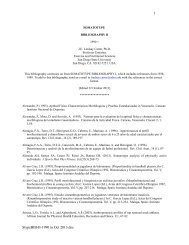THE HEATH-CARTER ANTHROPOMETRIC ... - Somatotype.org
THE HEATH-CARTER ANTHROPOMETRIC ... - Somatotype.org
THE HEATH-CARTER ANTHROPOMETRIC ... - Somatotype.org
You also want an ePaper? Increase the reach of your titles
YUMPU automatically turns print PDFs into web optimized ePapers that Google loves.
<strong>Somatotype</strong> Instruction Manual 15<br />
using Hotelling’s T 2 , with a Bonferroni adjusted alpha level. As noted above this is an appropriate<br />
analysis for the separate components, but not for the whole somatotype. Beunen et al. (1987), Bell<br />
(1994) and Rosique et al. (1994), applied the MANOVA procedures. However, these authors<br />
erroneously claim to have analyzed the “whole somatotype”, but in fact analyzed the three separate<br />
components.<br />
(e) Partial correlations. The stability of each component over time (i.e. repeated measures) can<br />
be assessed by calculating the interage partial correlations for one component while holding the other<br />
two components constant, i.e. r 1,23. Because there are moderate correlations between the somatotype<br />
components and there is reduced meaning of component values when taken out of the context of the<br />
somatotype, partial correlations are more appropriate and meaningful (Hebbelinck et al., 1995).<br />
Summary. This review has attempted to reinforce some basic principles of somatotype analysis<br />
and present new approaches. It points out differences between analysis of the whole somatotype and<br />
the separate components. In the future other methods will probably emerge and receive acceptance in<br />
the area of somatotyping. Finally, other tools should be used in conjunction with somatotyping to answer<br />
detailed questions regarding physique and composition.<br />
*********<br />
PART 3: EQUATIONS FOR SOMATOTYPE ANALYSIS<br />
The following equations are used in calculation and analysis of somatotype data. Items 1 and 2 are for<br />
calculating and plotting the somatotype. Items 3-6 are for analysis of the whole somatotype. Item 7<br />
suggests methods for comparisons by components.<br />
1. The anthropometric somatotype.<br />
Endomorphy = - 0.7182 + 0.1451 (X) - 0.00068 (X 2 ) + 0.0000014 (X 3 )<br />
Mesomorphy = (0.858 HB + 0.601 FB +0.188 CAG + 0.161 CCG) - (0.131 H) + 4.5<br />
Ectomorphy:<br />
If HWR ‡ 40.75, then Ectomorphy = 0.732 HWR - 28.58<br />
If HWR < 40.75 and > 38.25, then Ectomorphy = 0.463 HWR - 17.63<br />
If HWR £ 38.25, then Ectomorphy = 0.1 (or recorded as ½)<br />
Where: X = (sum of triceps, subscapular and supraspinale skinfolds) multiplied by (170.18/height in<br />
cm); HB = humerus breadth; FB = femur breadth; CAG = corrected arm girth; CCG = corrected calf<br />
girth; H = height; HWR = height / cube root of weight.<br />
CAG and CCG are the girths corrected for the triceps or calf skinfolds respectively as follows: CAG =<br />
flexed arm girth - triceps skinfold/10; CCG = maximal calf girth - calf skinfold/10.




